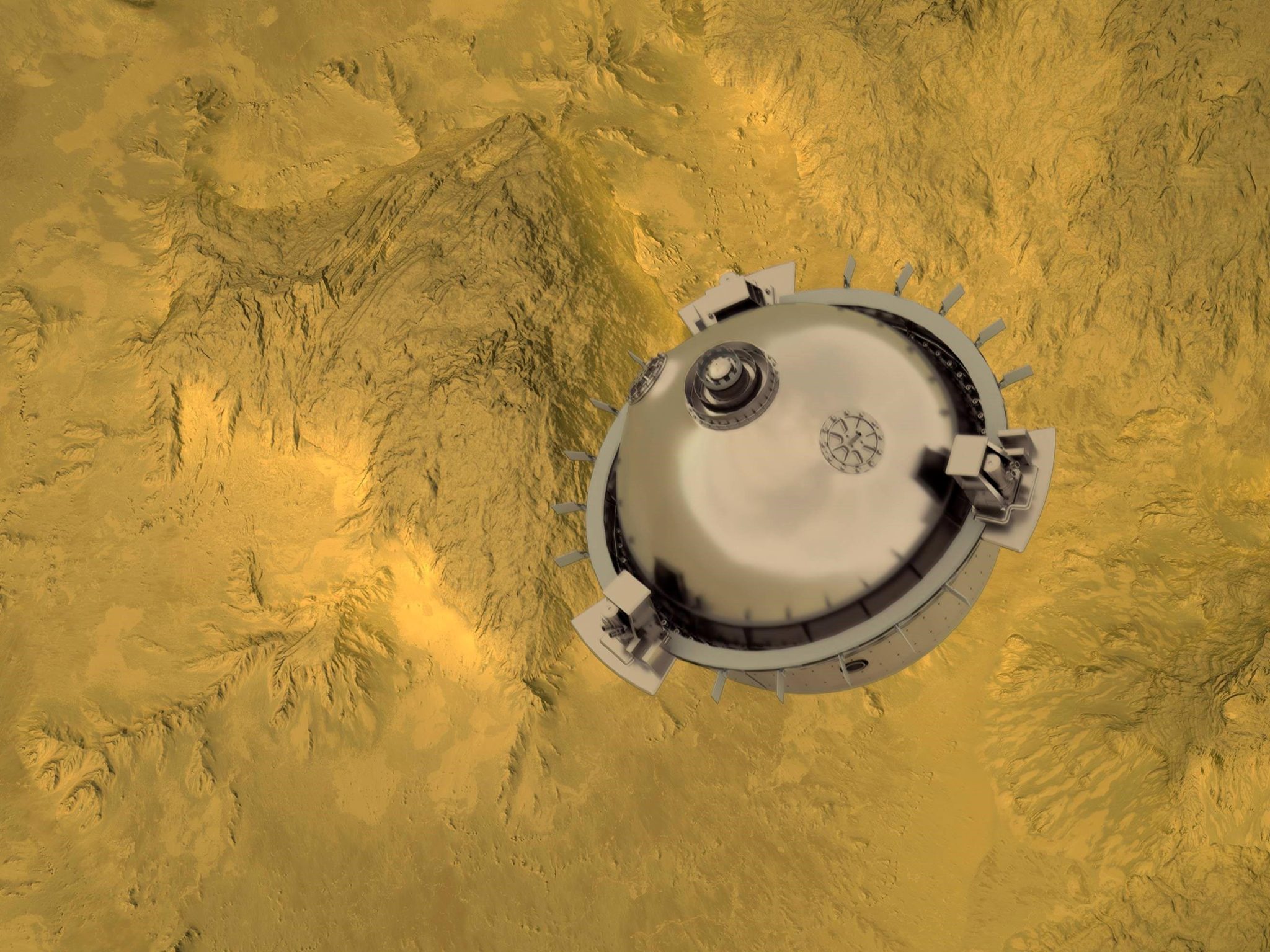

DAVINCI will send a meter-diameter probe to withstand the high temperatures and pressures near the surface of Venus to explore the atmosphere from above the clouds to near the surface of terrain that may have been a former continent. During the final kilometers of free-falling (artist’s impression shown here), the probe will capture stunning images and chemical measurements of Venus’ deepest atmosphere for the first time. Credit: NASA/GSFC/CI Labs
Inspired by Leonardo da Vinci’s Renaissance vision,[{” attribute=””>NASA is presently preparing its scientific return to Venus’ atmosphere and surface with a mission known as the “Deep Atmosphere of Venus Investigation of Noble gases, Chemistry, and Imaging” (DAVINCI).
The DAVINCI mission will “take the plunge” into Venus’ enigmatic history using an instrumented deep atmosphere probe spacecraft that will carry five instruments for measuring the chemistry and environments throughout the clouds and to the surface, while also conducting the first descent imaging of a mountain system on Venus known as Alpha Regio, which may represent an ancient continent. In addition, the DAVINCI mission includes two science flybys of Venus during which it will search for clues to mystery molecules in the upper cloud deck while also measuring the rock types in some of Venus’s highland regions.
All of these new and unique measurements will make the ‘exoplanet next door’ into a key place for understanding Earth and Venus-sized exoplanets that may have similar histories to our sister planet. DAVINCI will pave the way for a series of missions by NASA and ESA in the 2030s by opening the frontier as it searches for clues to whether Venus harbored oceans and how its atmosphere-climate system evolved over billions of years. DAVINCI’s science will address questions about habitability and how it could be “lost” as rocky planets evolve over time.
NASA’s DAVINCI mission will study the origin, evolution, and current state of Venus in unprecedented detail from near the top of the clouds to the planet’s surface. The goal of the mission is to help answer long-standing questions about our neighboring planet, especially whether Venus is as wet and habitable as Earth. Named after Renaissance artist and scientist Leonardo da Vinci, the DAVINCI Deep Atmosphere Venus Investigation mission for noble gases, chemistry and imaging is scheduled for launch in late 2020.
Video text:
It’s 900 degrees on the surface, has strong high-altitude winds, and is shrouded in a thick atmosphere of carbon dioxide.
Venus. Despite the same size and density as Earth, the similarities end there.
The earth has water and life.
The flower is desolate, dried up and seems lifeless.
The DAVINCI mission, named after Leonardo da Vinci, will take us back to Venus and address unresolved questions about this mysterious planet.
This exciting new mission will launch in June 2029.
During two gravity-assisted flybys, DAVINCI will study cloud tops in ultraviolet light, tracking cloud motions and analyzing mysterious UV-absorbing chemicals.
Both planes will also check the nighttime heat coming off the surface. These geological clues will paint a global picture of surface formation and evolution.
Seven months after our second flyby, DAVINCI will launch its Atmospheric Landing Probe, which will reenter the atmosphere over the course of two days.
It will take about an hour for the probe to descend into the atmosphere, and take measurements to the surface.
These measurements will include composition, wind, temperature, pressure and acceleration profiles.
The major gases will help us understand how Venus formed and evolved. Some of these measurements may reveal traces of ancient water.
The spherical probe houses state-of-the-art instruments that will work together to address questions about Venus’ atmosphere, protecting it from extreme temperatures, high pressures and acid clouds in the environment.
DAVINCI’s camera looks down through a small viewport, and once the probe passes below the clouds, it will begin to collect a series of 3D views that will also help us understand whether the rocks of the Alpha Regio Highland reveal the story of an ancient continent formed by water. The students’ collaboration experiment with oxygen sensing will reveal the role of this gas deep in the atmosphere.
The discoveries that emerge from this diverse dataset will help tell us whether Venus was ever habitable, and the story we uncover will reach far beyond our solar system to analog exoplanets that will be spotted with the James Webb Space Telescope.
Venus is waiting for us all and DAVINCI is ready to take us out there and ignite a new Venus renaissance.
NASA’s Goddard Space Flight Center leads the DAVINCI mission as the PI.

“Web maven. Infuriatingly humble beer geek. Bacon fanatic. Typical creator. Music expert.”





More Stories
Scientists confirm that monkeys do not have time to write Shakespeare: ScienceAlert
SpaceX launches 23 Starlink satellites from Florida (video and photos)
A new 3D map reveals strange, glowing filaments surrounding the supernova